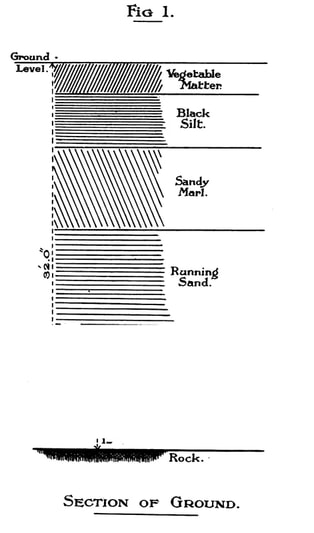NOTE ON A FIND BY MR. T. R. MORROW IN THE ALLUVIUM OF THE MERSEY AT IRLAMBY W. BOYD DAWKINS, D.Sc., F.R.S.,
HON. PROFESSOR, UNIVERSITY OF MANCHESTER From - Transactions of the Lancashire and Cheshire Antiquarian Society Volume 29, 1911 I am indebted to Mr. T. R. Morrow for the following account of a find of sufficient importance to be laid before the Lancashire and Cheshire Antiquarian Society as a fragment of the prehistory of the Manchester district.
The circumstances were that in digging for the foundation of a power-house for the Partington Steel and Iron Company, at Irlam, it was found necessary to pass through the alluvial deposits of the Mersey down into the solid rock. These presented the following section (fig. I). The strata are of the usual alluvial type of the lower Mersey-the finer sediments deposited by the river being the silts, marls, and sands, based on the coarser gravel that rests on the bunter sandstones below.
In this section, at a point 32ft. from the surface and 12ft. above sea-level, a flat discoidal waterworn implement apparently of coal-measure sandstone was discovered (fig. 2), perforated in the centre, the perforation narrowing towards the inside, as is generally the case with holes in stone, made by the rotation of a stick with sand, starting from the outsides and meeting in the middle. It is 5 1/16 in. long, 4.4in. broad, and 1.5in. thick. It belongs to the group of perforated stones that were used in the Neolithic and Bronze Ages for net-sinkers or weights for nets or for the heads of hammers. From its large size it probably belongs to the former class, and from the character of the perforation, I feel inclined to refer it to the Neolithic Age.
The interest of this discovery consists in the fact that it proves the presence of man in the district during the time of the accumulation of the lower gravel in the stream of the Irwell, that took place under different physical conditions to those now met with, and at a time when the current was swifter than that to which the upper finer sediments covering the gravel are due. The find stands, in relation to the surface, just as the human remains found in the excavation for the Preston docks, and the implements met with in the submarine forests of Cardiff, and the coasts of Somerset, near Minehead and Porlock, are related to the surface of the existing alluvia in each district-with this sole difference that, in the latter cases, the forests have sunk beneath the sea since they were the hunting grounds of man. It is probable that Lancashire also stood at a higher lever at the time of the deposit of the ground at Irlam than it does now, and that the coarser materials of which it is composed were carried down from the upper reaches by the greater swiftness of the Mersey due to the greater fall. From all these considerations, I conclude that the find at Irlam belongs to the earliest phase of the occupation of Lancashire by Neolithic man. |
AuthorCheyvonne Bower Archives
July 2024
Categories
All
|



